Energy & Natural Resources Report
 }
}
Executive Summary
- Executives believe their companies are outperforming the rest of the world in reducing emissions, but expect the rate of decarbonization to slow down over the next few years.
- Companies expect to deploy about a quarter of their capital on new growth businesses in 2023, many of these focusing on low-carbon technologies.
- Respondents say they aren’t concerned about accessing capital for low-carbon businesses, but need to ensure adequate returns on those investments.
- Talent shortages are impeding growth, especially for technical experts, as well as frontline workers in North America.
This article is part of Bain’s Energy and Natural Resources Report 2023
Executives in the fields of oil and gas, utilities, chemicals, mining, and agribusiness are on the front lines of the energy and natural resource (ENR) transition. While concerns about climate change and extreme weather grow, and customers and shareholders call out for rapid decarbonization, these executives are tasked with changing the way the world produces and uses energy, food, and many critical materials—all while keeping their businesses viable.
At Bain, we work closely every day with executives in these industries across the globe. Our annual survey seeks to assess their opinions and attitudes about the progress of the energy and natural resource transition, how their companies are managing through these changes, and what barriers they see ahead. This year, we found executives expecting a slowdown in the rate of decarbonization in the short term (by 2030), though their long-term expectations remain largely positive.
Our 2022 report found executives grappling with increasing complexity and a disorderly transition as they balanced carbon-reduction efforts with the economic realities of their businesses. In the year since, we’ve seen this complexity exacerbated by geopolitics, which produced imbalances in the energy ecosystem and may have contributed to executives’ belief that a short-term slowdown is at hand. Executives remain confident about their own abilities to manage through this complexity to a lower-carbon future, but are less confident about the world at large.
These findings come out of our discussions with clients and our survey in early 2023 of more than 600 executives across the energy and natural resource sector. As last year, we wanted to get a better idea of their views on the energy and natural resource transition, new technologies and investment opportunities, and where they see the greatest challenges for decarbonization.
Among the most interesting findings:
- Most executives still believe their own companies are doing better on the path to net zero than the world as a whole, and about one-third believe they’re doing better than their peers.
- Companies expect to deploy 24% of their capital on new growth businesses in 2023. North America is catching up with Europe.
- Access to capital for new low-carbon investments isn’t a major constraint, but ensuring a return on investment certainly is. Most customers aren’t willing to pay much more to support these new businesses at scale, so companies will need government policy support to incentivize the investment.
- Renewables, artificial intelligence (AI) and other digital technology, and energy storage are the most critical technologies for the sector through 2030. Executives in the Middle East are bullish on hydrogen and carbon capture, but executives in most other regions expect these technologies to become more important only after 2030.
- Talent shortages are a significant barrier, especially for frontline workers in North America and the Middle East and for engineers and digital experts in all sectors.
Global perspectives
Executives anticipate a slowdown in the rate of decarbonization over the next few years (see Figure 1). But a slowdown is expected to be modest, and their long-term expectations haven’t changed. Although efforts to decarbonize are still progressing, turmoil in energy markets resulted in more coal being burned to make up for shortfalls in Russian-supplied natural gas. Several told us that the events of 2022 could shift the focus of investments back toward addressing scarcity and making energy affordable in the short term. However, geopolitical events also accelerated the deployment of capital to renewables as countries and companies look to become more self-sufficient.
“The success of the pivot to clean energy technologies will be determined by the extent to which people see the benefits while minimizing disruptions—with focus on affordability and fairness.”
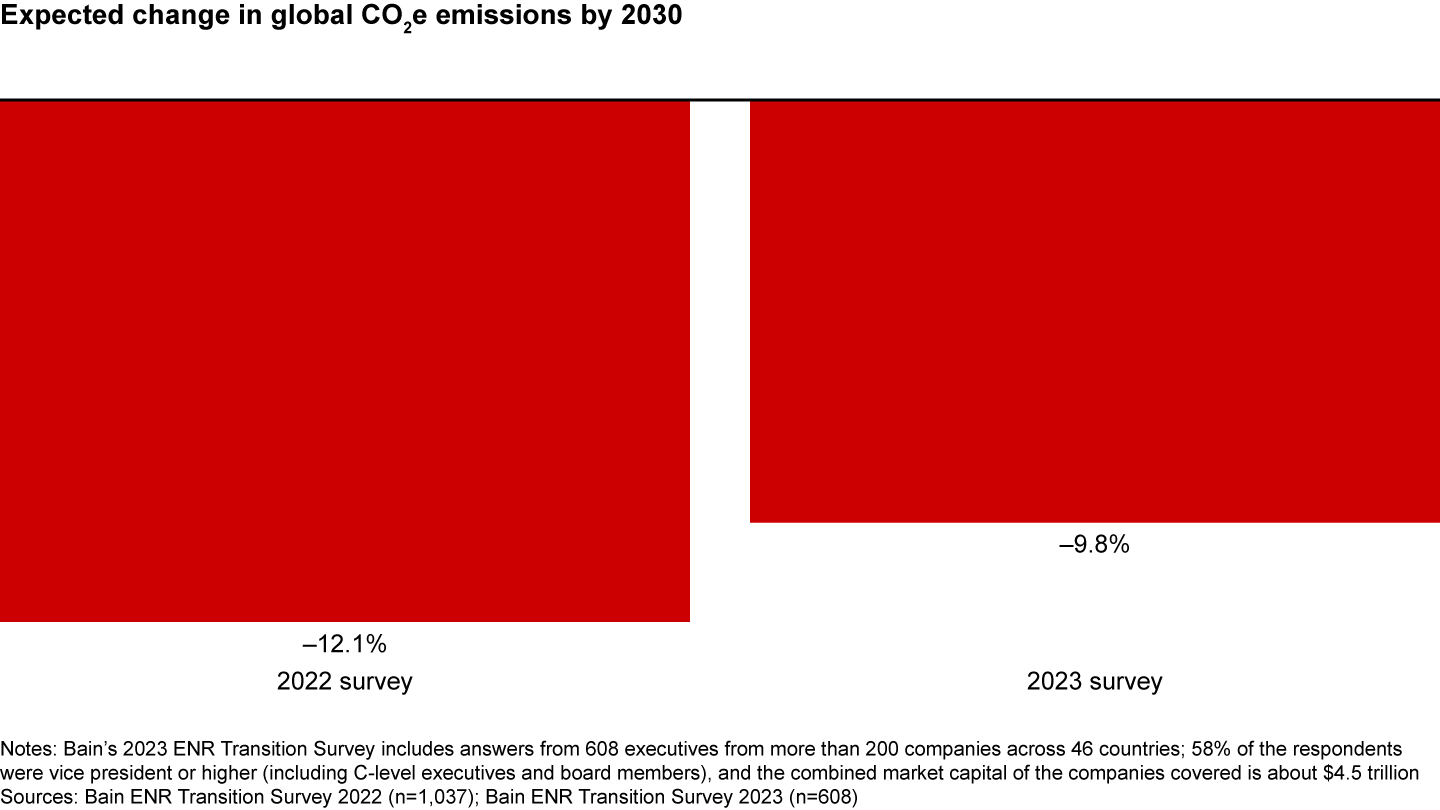

Averaged across our survey participants, 2057 remains the consensus date when the world could reach net-zero carbon emissions (see Figure 2). As a group, they expect emissions reductions to broadly track current pledges through 2030, then accelerate to achieve net zero by 2057. For this to happen, a lot would have to change after 2030. For example, the International Energy Agency estimates that for the world to reach net zero by 2050, annual investments in clean energy would need to increase to $4.6 trillion by 2030 from the 2022 level of about $1.6 trillion. All the while, the companies implementing these investments must also ensure that these projects are economically viable and can be executed given physical constraints (for example, availability of materials, labor, supply chain).


About one-third of executives believe their own companies are further along the path to net zero than their peers, and two-thirds believe they’re moving faster than the world as a whole.
Reduction of Scope 1 and 2 emissions remains the top ESG priority for energy and natural resource companies (88% rank emissions reduction in their top three issues). ENR executives are also thinking about their impact on local communities, a point that remains a top-three issue in all regions other than Europe, where it ranks below Scope 3 emissions and circularity (see Figure 3). Interest in circularity is also growing. In the chemicals sector, it’s a top-two priority, and we’ve seen an 8- to 10-percentage-point increase in interest in agribusiness, mining, and oil and gas, where roughly one in three executives consider it a top-three priority.


Four out of five executives consider the ability to create acceptable returns on projects a main barrier to decarbonization of the energy system. Their concerns are based on customers’ unwillingness to pay—not universal, but enough to make it hard to scale low-carbon businesses. So they look to government policy and regulatory support to help bridge the gap. Fewer than 20% expressed significant concerns about accessing capital (see Figure 4).
“Transition will not occur if it has a negative impact on companies’ economic bottom line. Companies cannot transition if their businesses are at risk by doing so.”
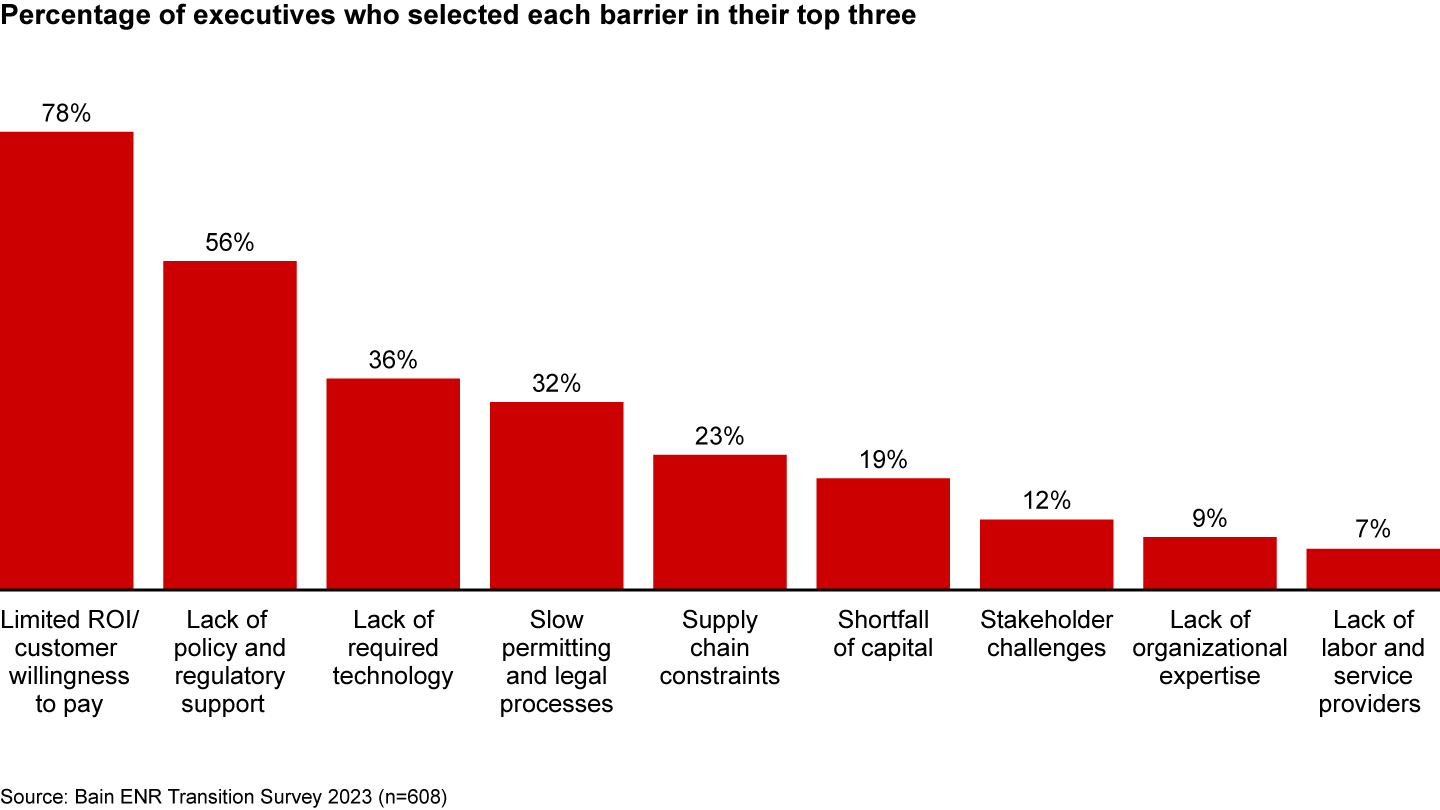

Slow permitting is also a major concern, even where the policy environment is more accommodating. Most North American utilities executives cited it as one of their top concerns, although they also see policy as much less of a barrier than do their counterparts in Europe and Asia (see Figure 5). In Europe, where more than half of executives from the utilities and mining sectors cite slow permitting as a top issue, the European Union has announced a draft regulation that aims to reduce permitting times for large energy transition projects to no more than 12 months.
“While it can be a worthy goal to cut emissions, there will be a large societal cost if we move too quickly in the short term and leave people at risk of dying because they can’t afford to heat their homes.”
Surprisingly, not many executives identified service providers (e.g., engineering, procurement and construction contractors, as well as maintenance companies) as a bottleneck. Only 7% flagged it as a major problem, possibly because many decarbonization projects are still at early stages with only limited capital deployed so far.
In the Asia-Pacific region, availability of technology also shows up as a critical barrier.
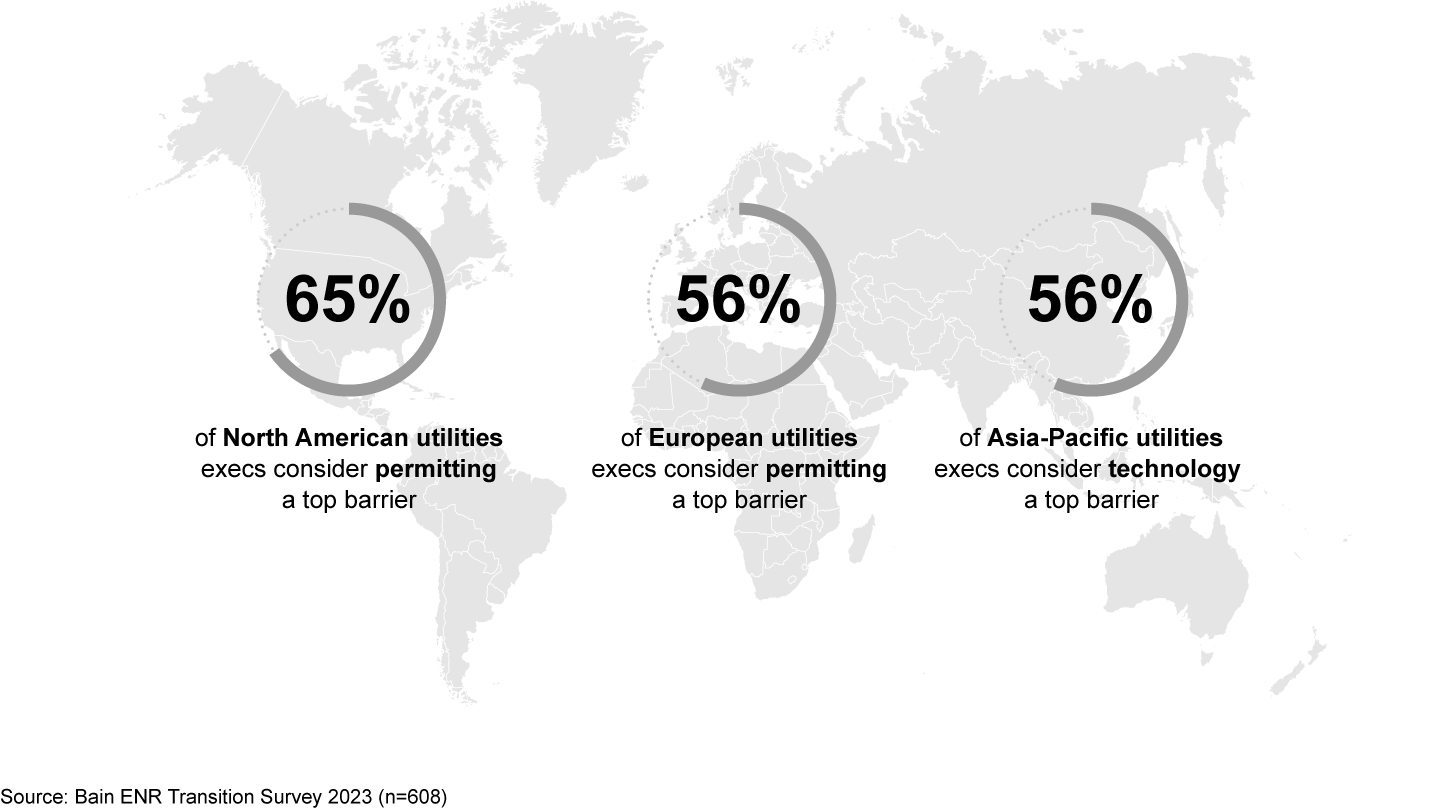

"The complications in developing economies is the reliance on the core businesses for provision of labor and economic opportunities which may not be replicated in the energy transition."
Other executives expressed concerns about price spikes if fossil fuels are defunded too quickly and energy supply cannot meet demand. Some also described a lack of understanding on the part of policymakers, the media, and the public about the interconnectedness of the energy system, and they look to governments to help determine realistic paths and goals.
“There is a basic lack of understanding of how a fully decarbonized system may work and at which cost. Policymakers yearly increase decarbonization targets, without any reality check. Top-down processes are predicted to fail unless they find support from people, especially when these targets erode spending power by increasing the cost of energy and fuels.”
Prospects for core businesses
Events of the past year show no significant effect on executives’ beliefs about the durability of their core businesses. Executives in utilities and new energy are most optimistic, with nearly two-thirds expecting their business to grow rapidly, owing to continued tailwinds from electrification and low-carbon energy increasingly a part of their core business. The percentage of oil and gas executives anticipating a rapid decline of their core business over the next 10 years fell to 4% from 8% the previous year. But, as last year, about half still expect some decline (see Figure 6).
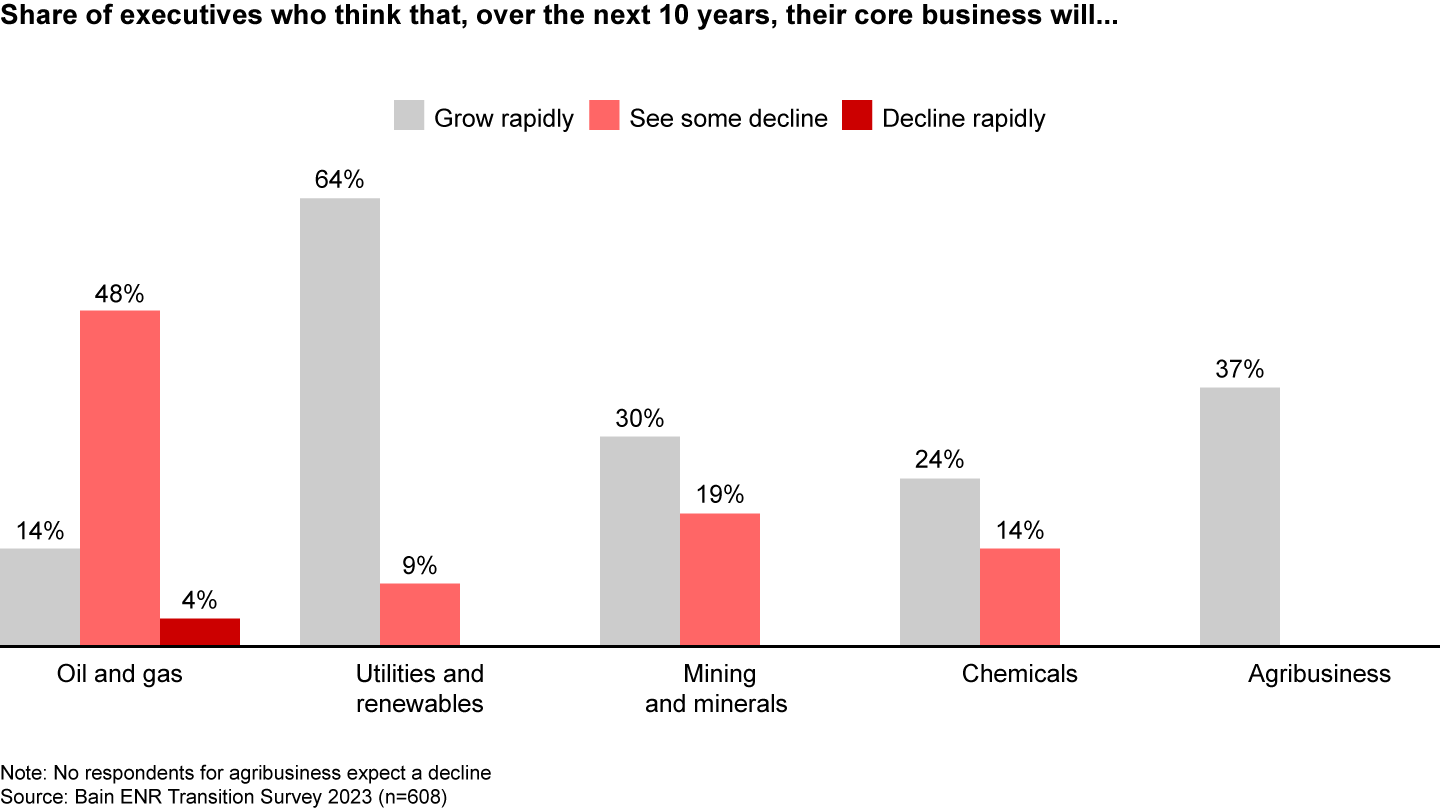

Capital for low-carbon business. ENR companies plan to allocate more capital to new, low-carbon growth areas. Across sectors, they plan to allocate about 24% of their capital to new growth businesses in 2023, up from 16% in 2020, consistent with the trend we saw last year (see Figure 7).
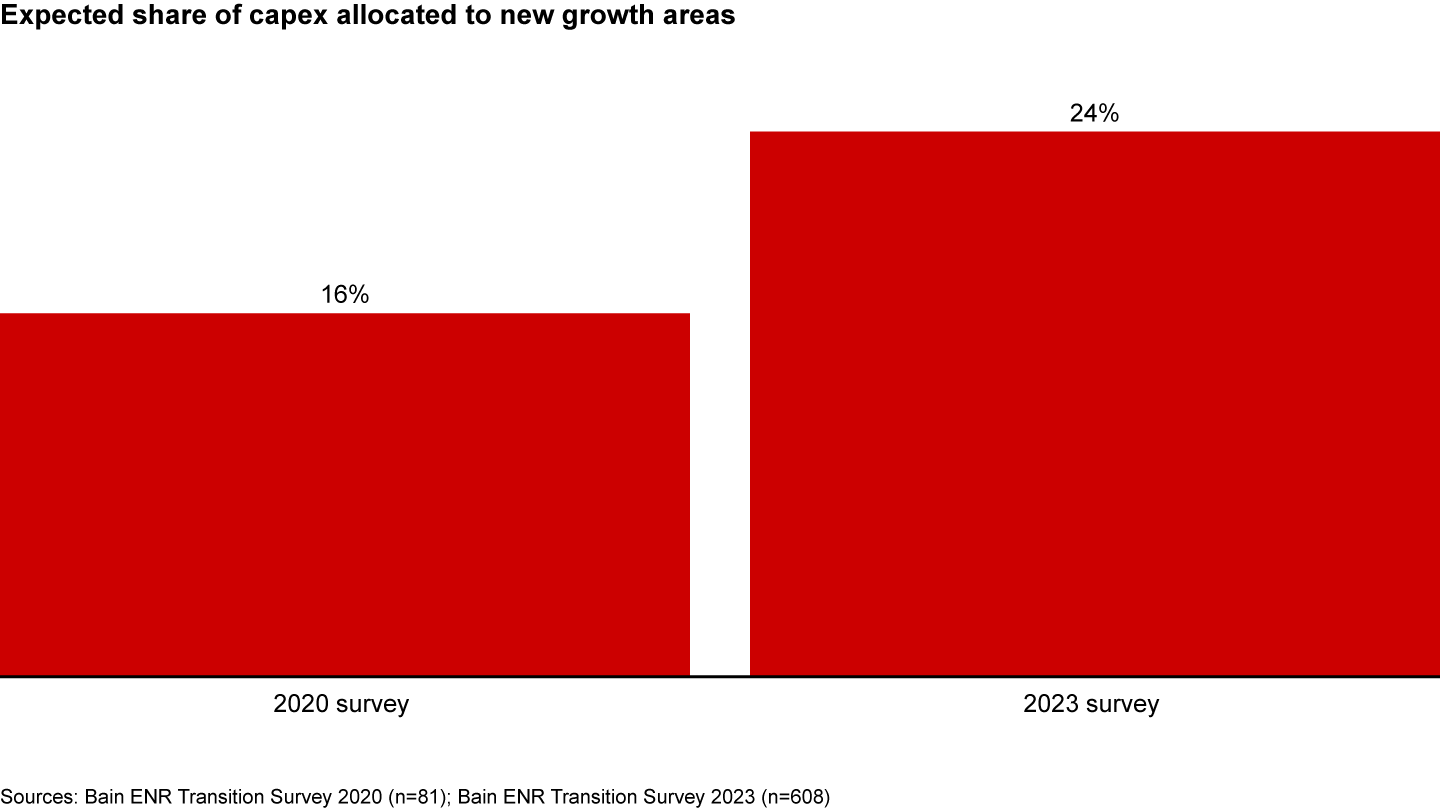

Regionally, North America is catching up with Europe due to incentives included in the US’s Inflation Reduction Act (IRA)—an early indication of how quickly companies can react to positive policy signals (see Figure 8). As a result, some executives in other regions expressed concerns about competitiveness and the need for equivalent policy support in other countries.
“In the transition process towards a more sustainable industry, policymakers must make sure that Europe can maintain its competitiveness vs. other regions that do not apply the same environmental standards.”
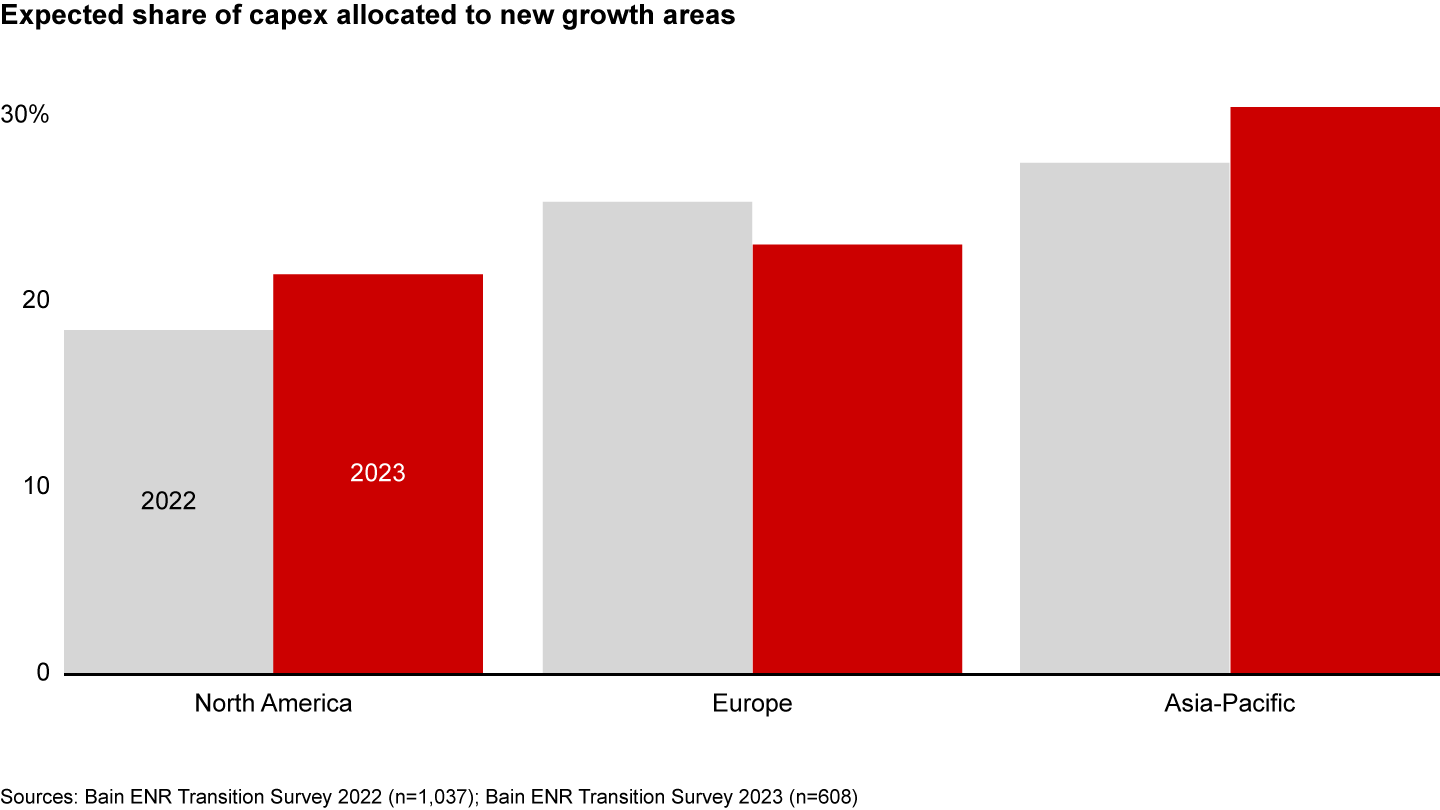

Across sectors, executives expected about the same levels of capex investment, except in mining, where expectations increased significantly, possibly in response to rising demand for transition minerals like copper, nickel, and lithium (see Figure 9).
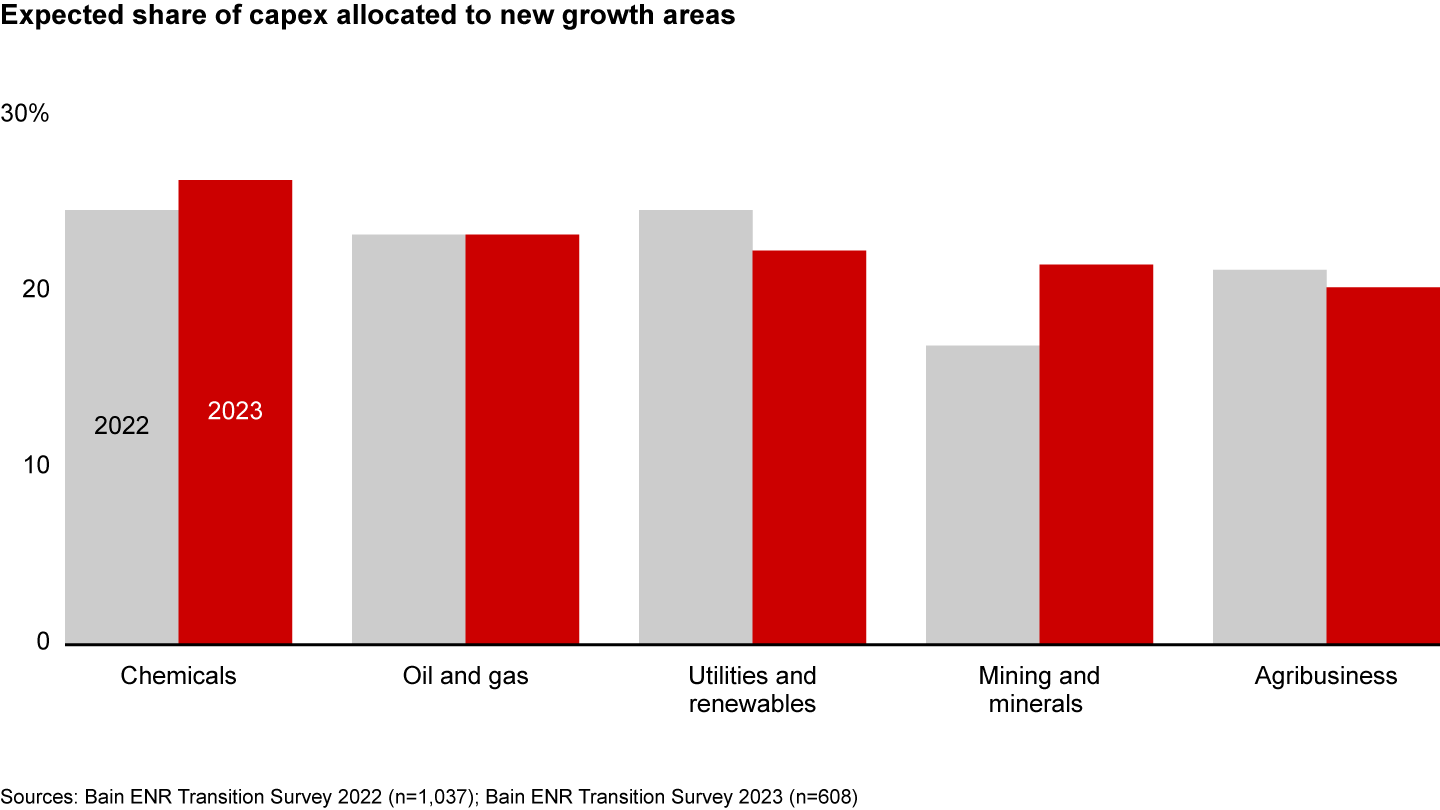

New technologies. As they did last year, executives believe the three most important technologies for 2030 will be renewables, digital, and energy storage. By 2050, they expect hydrogen to replace digital as a key technology, with more than four in five believing it will have a significant impact on their business. We found other notable spikes by region and sector (see Figure 10).
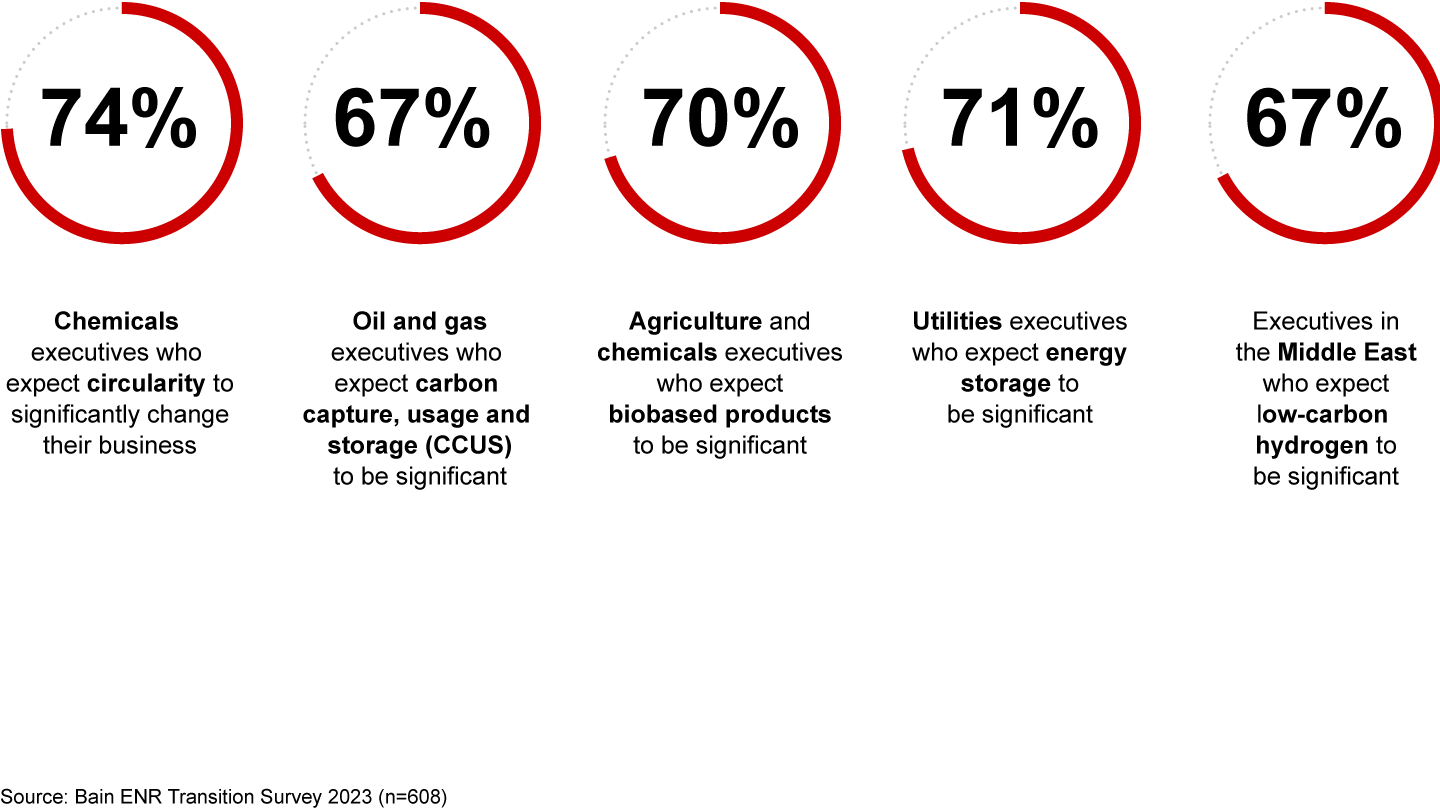

Scaling new businesses. Executives remain confident that their low-carbon businesses will become significant by 2030, with 70% expecting these businesses to account for more than 10% of company profits or valuation by 2030 (see Figure 11). We see some variation by sector. For example, executives in mining and minerals raised their expectations significantly this year, whereas oil and gas execs showed a bit less optimism in the prospects for their new, low-carbon businesses, perhaps due to improved medium-term prospects for their legacy ones.
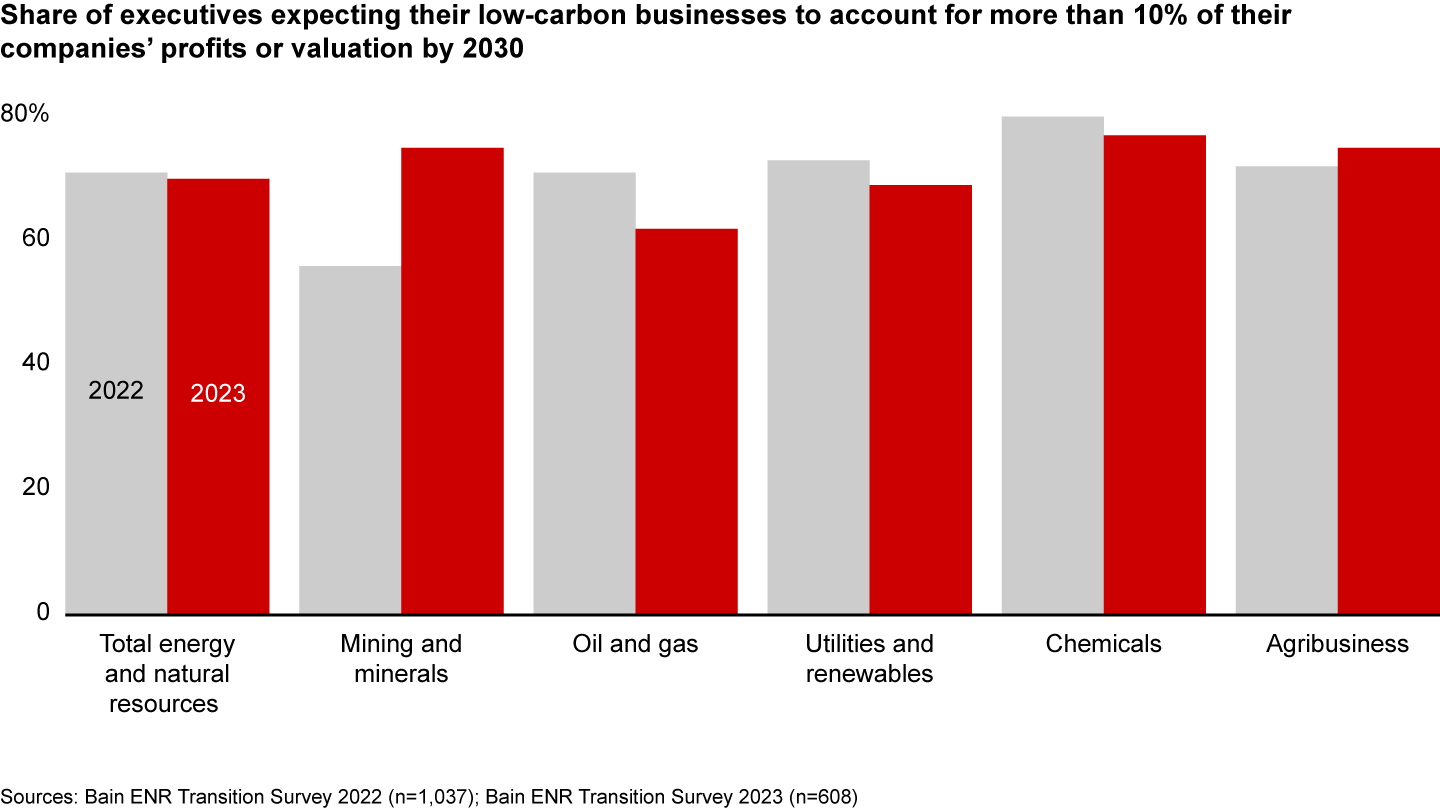

“[The energy transition] is something essential for survival, and it will arrive sooner than expected.”
However, scaling low-carbon businesses remains extremely challenging. Executives told us that the roadblocks are less about bold ambition and company culture and more about building a scalable model that delivers acceptable returns (see Figure 12). (For more on the early lessons from Engine 2 buildouts, read the Bain Brief “How to Do Engine 2 for the Energy Transition.”)
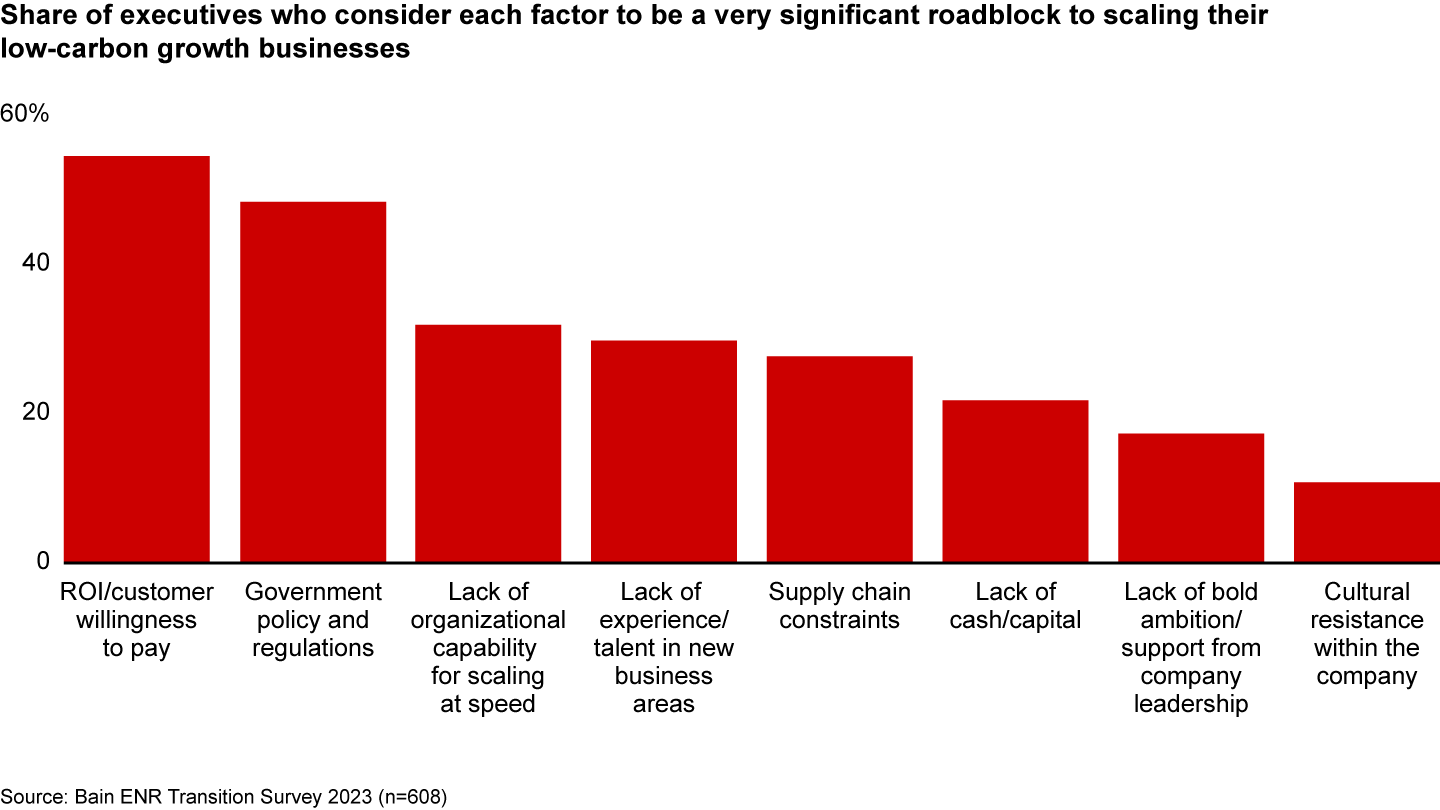

Return on investment remains a significant challenge for individual companies, which they are addressing by being more selective and focusing on opportunities that generate acceptable returns. Maintaining those acceptable returns while scaling new growth businesses remains difficult since most customers are unwilling to pay higher prices for essential mass market goods and services. Government policy and regulatory support are critical to develop and grow these markets. Investors may also need to reconsider their capital allocation strategies in order to fund the lower-risk, lower-return investments needed in some new low-carbon businesses. Companies also cite uncertainty about access to talent and organizational capabilities as serious impediments to growth.
While government policy and permitting remain the predominant roadblocks to the growth of new, low-carbon businesses in the sector, our survey revealed regional nuances. For example, almost twice as many European oil and gas executives blamed policy uncertainty for delayed investment decisions, compared with the previous year (61% vs. 36% in 2022), while fewer executives in North America assigned similar blame (50% vs. 59%), possibly showing the effects of the IRA (see Figure 13).
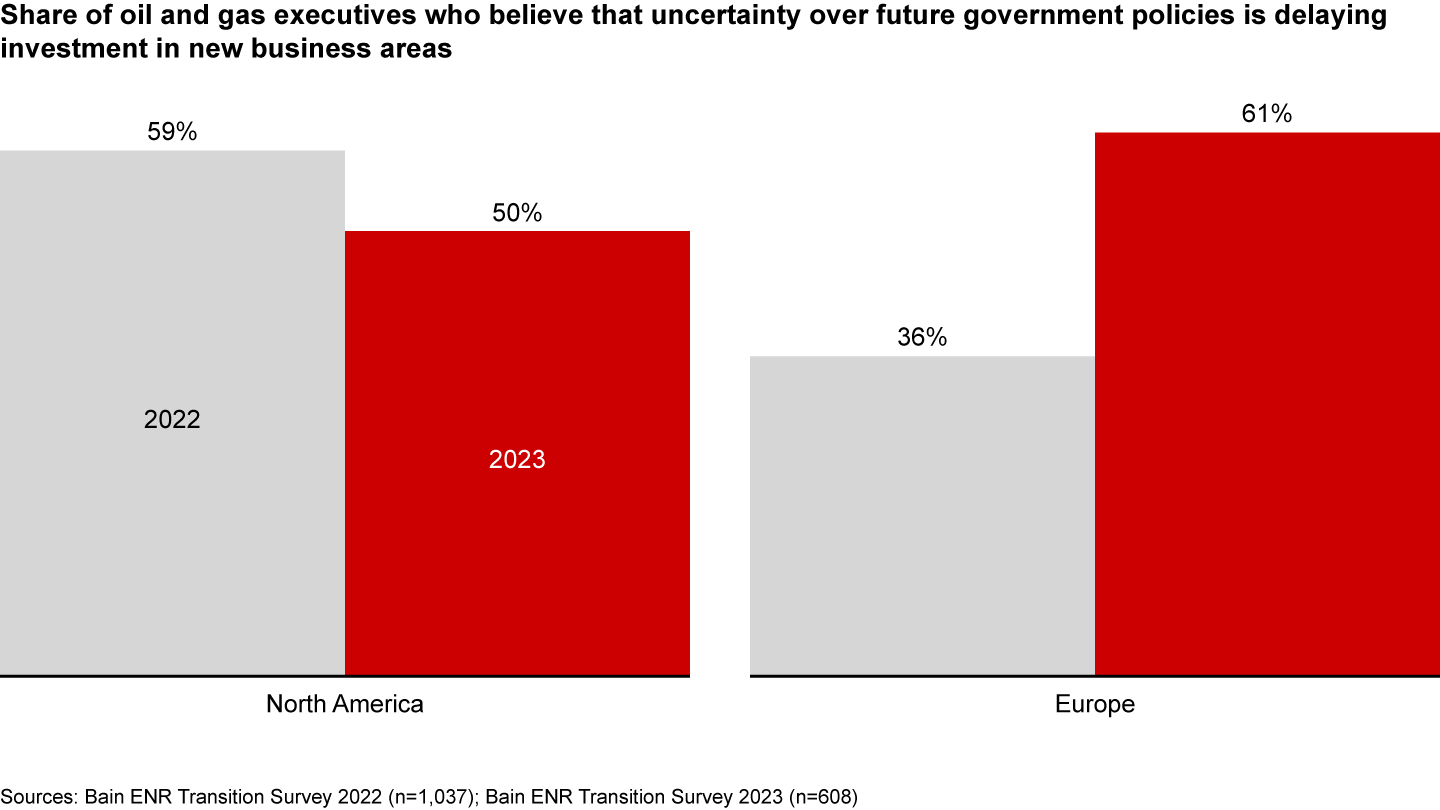

Building organizational capabilities and finding talent remain major challenges for growing low-carbon businesses, especially in several key roles (see Figure 14). Digital and information technology talent is at a premium in all sectors and regions. About 60% of executives expect digital and AI technologies to change their businesses significantly by 2030, but they’re struggling to find talent that can help them manage the change. In addition, about one in three companies report difficulty finding the engineers they need, and one in four are having trouble hiring frontline workers.
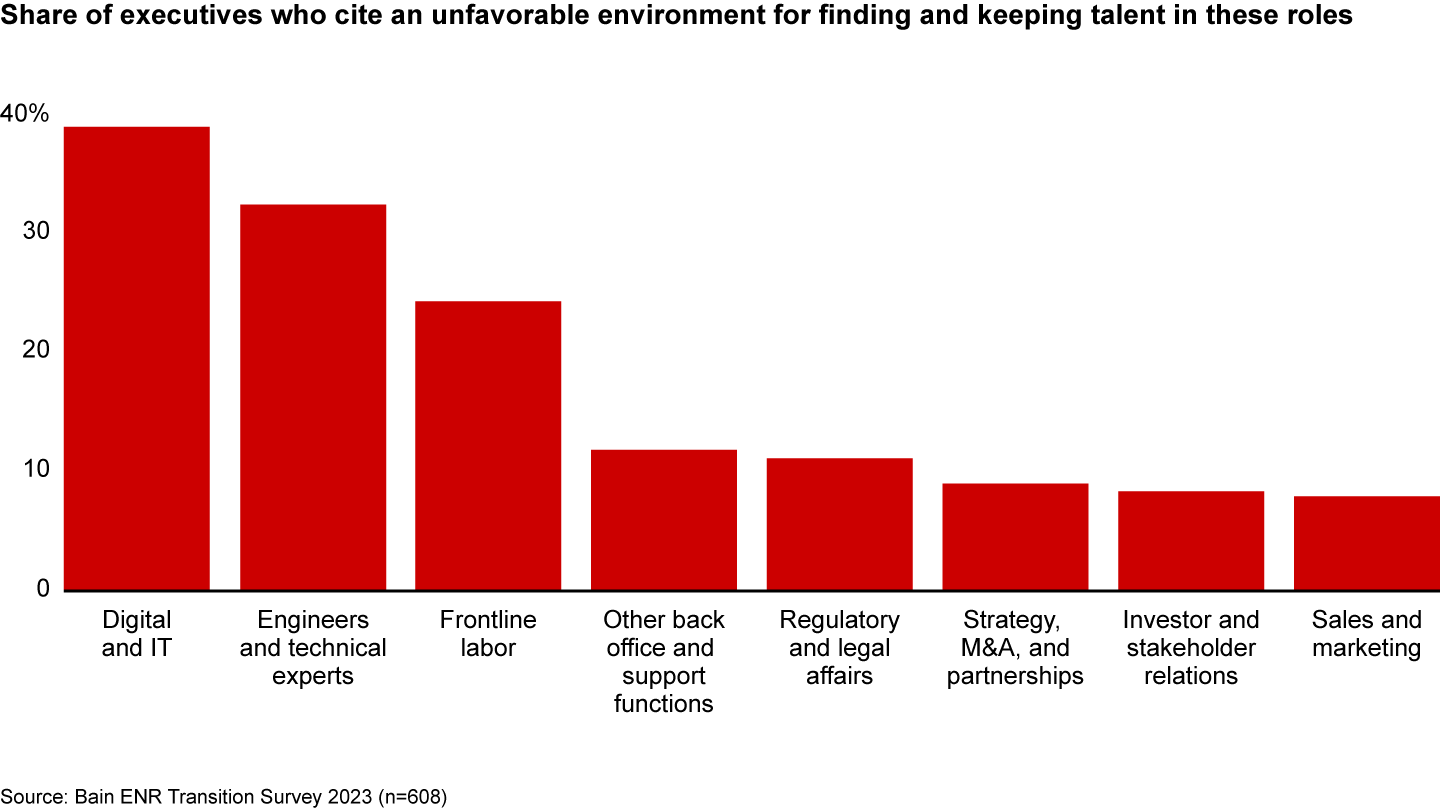

The situation is more acute in North America, where 39% of companies are having difficulty finding frontline labor (see Figure 15). Talent is the top roadblock to scaling growth businesses in the Middle East, where 42% of companies have difficulty finding frontline workers and 33% have trouble finding sales and marketing talent. The market for frontline workers appears much more favorable in Latin America and Asia.
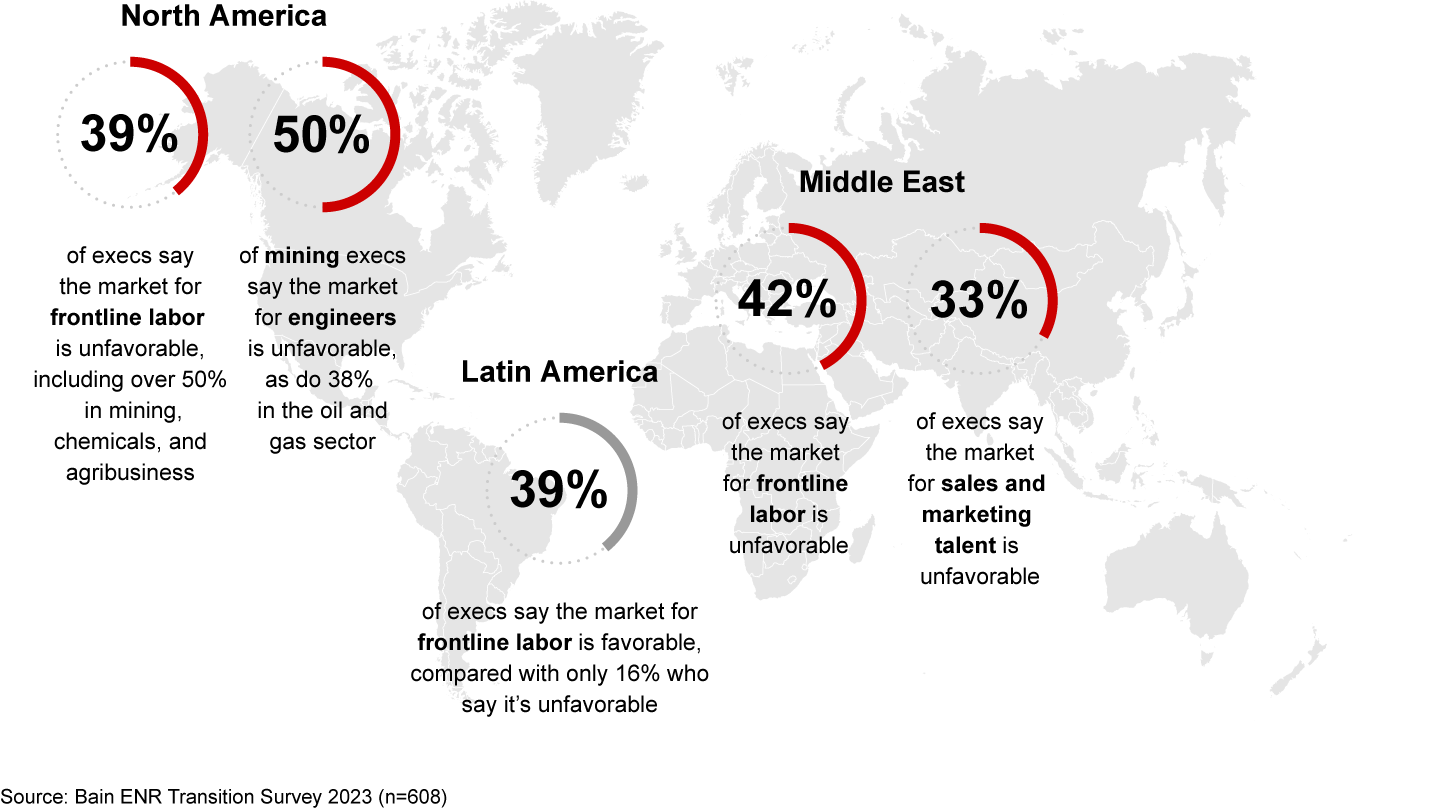

A final point of concern is the issue of resilience. Our survey found executives confident or very confident about their company’s resilience to the physical effects of climate change—though whether this confidence is justified remains to be seen (see Figure 16). Observing the industries in the energy and natural resource sectors, we believe that risks to physical assets may be greater than many companies anticipate, and these risks haven’t been fully factored into their planning and capital deployment. In other aspects of resilience, executives are more concerned. For example, fewer than one in five are very confident of their resilience to supply chain bottlenecks, which are likely to become even more acute as new businesses with new supply demands (for example, new feedstocks for recycling or biofuel) attempt to scale.


While energy and natural resource executives see real challenges in policy, permitting, talent, and scaling new businesses that can generate acceptable returns, they remain committed to steadily increasing capital deployment and playing their part in the world’s bumpy journey to net zero by the late 2050s.